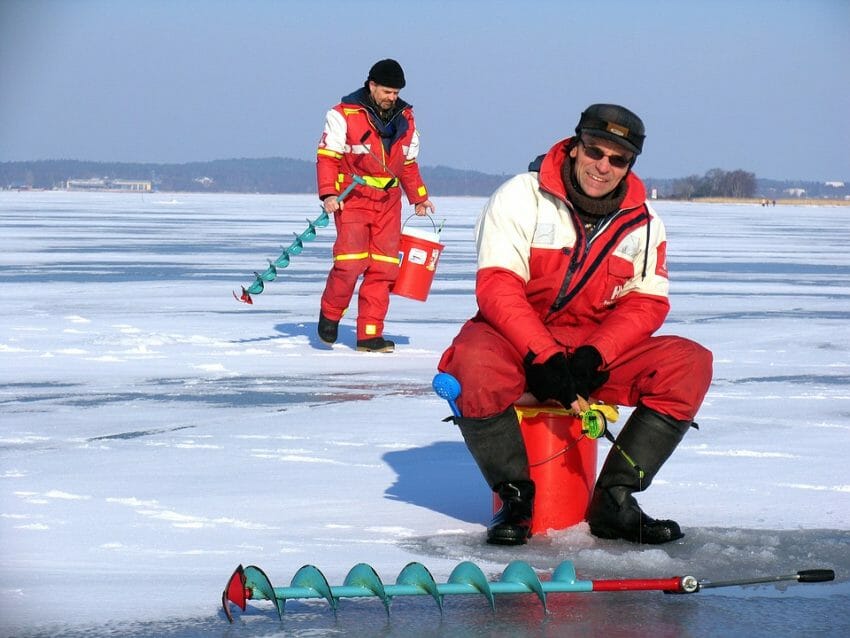

As winter comes, the fishing season does not have to come to a close. Ice fishing is a popular form of fishing, and there is plenty of fish to be caught in the winter. Ice fishing is different from other forms of fishing, however, so you may need to update your gear to transition from fall fishing to winter ice fishing. Stock up on the essential ice fishing equipment you’ll need so that you can fish year-round.
Essential Ice Fishing Gear:
- Ice Fishing Rod and Reel
- Ice Fishing Line
- Ice Fishing Lures and Bait
- Ice Auger and Scoop
- Metal Cleats and Safety Picks
Ice Fishing Rod and Reel
If you’ve gone fishing before, you probably already have a rod and reel. Ice fishing is very different from other forms of fishing, however. While you could theoretically use a standard freshwater rod and reel for ice fishing, it’s best to get the right gear so that you can catch more fish.
Standard fishing rods are usually longer than ice fishing rods, which are typically only 2 to 4 feet long. Since you’re simply dropping your line through a hole in the ice and not casting, you don’t need the length of a typical fishing rod. A shorter rod makes it easier to work angles around a small hole in the ice. Ice fishing rods are also made to be very sensitive, as bites tend to be subtle when ice fishing.
Ice fishing reels are made to match ice fishing rods. They are usually lighter and smaller, so if you’re buying a normal fishing reel, buy the smallest size. Typically, ice fishing reels are spinning reels. Fly reels also work well for ice fishing if you don’t want to buy a new piece of equipment. For ice fishing, aim to use ultra-light rod and reel equipment.
Ice Fishing Line
Your rod and reel are useless without the fishing line! When ice fishing, you might not want to use your standard line, as it might not hold up against the cold temperatures. You can use monofilament, braided line, or fluorocarbon, but there are pros and cons to each.
We recommend fluorocarbon or a copolymer hybrid line for ice fishing. These have low visibility, which is important for ice fishing. Fluorocarbon lines sink easily, are highly sensitive, and are super abrasion-resistant. The only downside is high memory and coils worsened by cold weather. The copolymer is also very sensitive, abrasion-resistant, and non-absorbent so it works well in freezing conditions.
You can also use mono or braided line; both are still very popular for ice fishing. Buy line made specifically for ice fishing so that it is optimized for the winter conditions. Look for ice fishing line with a more invisible color, low stretch, and high sensitivity.
Ice Fishing Lures and Bait
Using the wrong bait or lures will hurt your chances of making a catch. Each type of fishing and even each species of fish requires different bait to attract the fish to bite. Ice fishers generally use jigs for lures, as they are incredibly effective in catching panfish, walleye, and other ice fishing species.
Live or cut bait is also very popular, and the scent can lure in fish. Waxworms, maggots, spikes, and minnows work well for ice fishing.
Ice Auger and Scoop
Ice fishing would be tough if you couldn’t get through the ice. An ice auger is the tool anglers use to cut a hole in the ice. There are different types of ice augers, from manual hand augers to electric or gas-powered augers. Beginners should probably use a manual auger for safety purposes and to get the hang of it.
Once you’ve cut your hole through the ice with your auger, ice, slush, and snow will fill the hole. This is why it’s helpful to also have an ice scoop to clear out your hole so that you can easily drop a line and retrieve fish. A metal ice scoop is durable and works well in the cold temperatures.
Metal Cleats and Safety Picks
There are certain safety precautions you need to take when ice fishing. You’ll be walking and fishing directly on frozen water, so it’s vital that you stay safe from potential injuries caused by slipping on the ice or falling into the freezing water.
Metal cleats or ice cleats are necessary for traction when walking on ice. You can buy ice fishing boots that are made with metal cleats, or you can buy attachments to add to your standard fishing boots. The metal studs or spikes on the bottom of the shoes will keep you from falling on slippery patches of ice.
Safety picks are ice picks that anglers typically wear around their necks. They are connected by a retractable cord. If you should fall through the ice, you can use safety picks to get back up. They can be plunged into the ice so that you have a grip to pull yourself out of the water.
Pack Your Gear and Dress for the Cold
Aside from the essentials on this list, you’ll need the standard fishing gear you bring on every fishing trip: hooks, weights, and other terminal tackle, coolers for fish, and tools like pliers and knives for cutting line. It’s also vital that you dress for the weather! Frostbite is no joke, so layer up with warm socks and clothes, a sturdy jacket, hats, gloves, and other cold-weather necessities to keep you warm.







